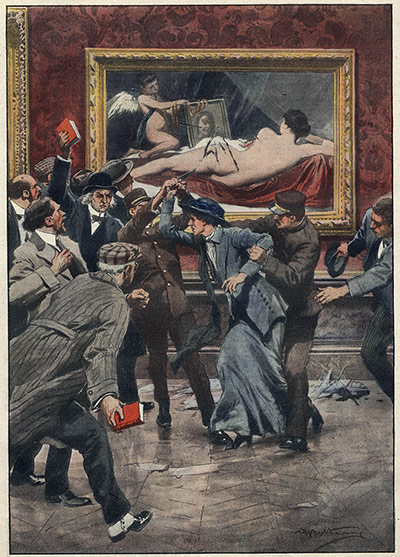The news item that interested me most in the past week is about the vandalising of a Mark Rothko canvas in the Tate gallery. The kind of outcry that this caused was quite interesting. An article by Jonathon Jones in The Guardian described it as virtually a sacrilegious act even though it’s not a religious painting. He displays a sense of awe and wonder that puts all Great Artists on a pinnacle and compares their work to some kind of deep spiritual experience. Other articles in the same paper either give a history of the grand tradition of vandalising art or described works of art that might be improved by vandalism!

Included in his article Jonathon Jones expresses outrage concerning the vandalism of Michelangelo’s Pieta with a hammer. I dare say many people share this outrage and agree with the many comments on Twitter that would condemn these perpetrators to torture, death or worse. However, there as been a long history of vandalising Great works of art. I am writing this in Florence, Italy and found out before this recent act that Michelangelo’s iconic sculpture David was vandalised with a hammer shortly after it was erected. It seems that hammers, knives and machetes are the most favoured weapons of destruction for vandalising art but shotguns and sulphuric acid have also been used. The statue symbolised Florence’s republican resistance to the autocracy of the Medicis (David versus Goliath) and was seen as a legitimate target by the supporters of the aristocracy! But perhaps the biggest collective act of vandalism occured during the English Civil War when a massive amount of art work and buildings were destroyed by the Puritans. Henry VIII was quite a major perpetrator as well when he dissolved the monasteries in search of loot!

Vladimir Umanets was an unknown Pole until last week. Now he has achieved celebrity by tagging Rothko’s “Black on Maroon” at the Tate Modern. He compares himself to Marcel Duchamp who signed a urinal and presented it for exhibition in 1917 thus creating perhaps the first piece of conceptual art. He also likens himself to Damian Hurst who has signed his name to work he has not done. Umanets has said he is part of a new art movement (consisting of him and one other) called Yellowism. He expresses an appreciation of Rothko’s work who he sees as a seminal Yellowist. Now, is this guy crazy or is he making a valid point?
Duchamp famously produced a post card featuring the Mona Lisa on which he drew a moustache and goatee beard. No doubt, he would have preferred to have defaced the real picture but was either unable to or too scared of the consequences. Either way it was a controversial act that blew a giant raspberry at the art establishment and became iconic in it’s own right and later, in a parody of the conventions of classical art, was copied by Salvador Dali albeit with a different moustache. Dali had his own style in vandalism. When presented with a picture by Andy Warhol, apparently he threw it on the floor and pissed on it. Warhol remained calm and detached throughout. Perhaps he couldn’t decide whether it was a compliment or an insult!

I think Umanets was quite brave in what he did. Witnesses say he sat quietly for a long time and then wrote on the painting with a black pen. He knew he would be caught and was ready with his explanation. Unfortunately, he either hasn’t said (or it hasn’t been reported) what Yellowism actually is. This would make it more meaningful like the anti-war protest perpetrated on Picasso’s Guernica. Defacing Great works of art will always get you attention and will guarantee you a place in history (although maybe for all the wrong reasons)!

Another remarkable case of vandalism was when suffragette Mary Richardson attacked Rokeby’s Venus with a meat cleaver. This actually became a picture in itself. She was drawing attention to the hunger strike of Mrs. Pankhurst that was happening at the time. Considering the subject matter of the painting it could also been seen as an act of proto-feminism.

Personally, my favourite piece of art vandalism is when two Chinese students stripped to the waist and had a pillow fight on Tracy Emin’s Bed. Although, in this case, a more effective piece of vandalism would be if someone sneaked in and tidied it up and washed the sheets. Now that would be hilarious!

Leave a Reply